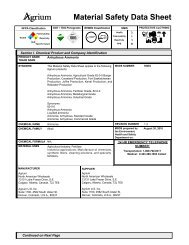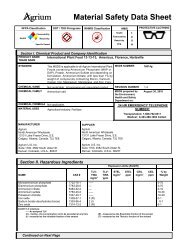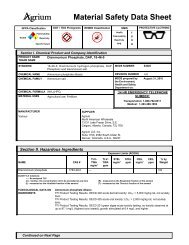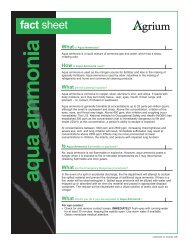ESN Wheat Fact Sheet 0408.qxp - Agrium Wholesale
ESN Wheat Fact Sheet 0408.qxp - Agrium Wholesale
ESN Wheat Fact Sheet 0408.qxp - Agrium Wholesale
Create successful ePaper yourself
Turn your PDF publications into a flip-book with our unique Google optimized e-Paper software.
A New Generation in<br />
Smart Nitrogen<br />
Controlled Release Fertilizer<br />
A smarter source of nitrogen. A smarter way to grow.<br />
wheat
<strong>ESN</strong> - A New Nitrogen Technology For <strong>Wheat</strong><br />
<strong>ESN</strong> Recommendations For <strong>Wheat</strong><br />
Establish Proper Nutrient Management Practices<br />
All sound nutrient management programs start with proper soil testing.<br />
The maximum benefits of <strong>ESN</strong> will not be realized if other limiting factors<br />
are not properly managed. Take a good soil test following recommended<br />
procedures and apply other nutrients and lime as recommended from the<br />
soil test. Eliminating other soil chemical, physical, and biological limitations<br />
will help realize the maximum benefit from <strong>ESN</strong>. We do not recommend<br />
<strong>ESN</strong> without proper soil testing.<br />
2<br />
<strong>ESN</strong> - A New Nitrogen<br />
Technology For <strong>Wheat</strong><br />
<strong>ESN</strong> is a new agricultural grade<br />
controlled-release nitrogen (N)<br />
fertilizer from <strong>Agrium</strong>. <strong>ESN</strong><br />
maximizes N-use efficiency and<br />
minimizes N losses to the<br />
environment by encapsulating N<br />
inside a special polymer coating.<br />
Predictable Nitrogen Release<br />
The unique coating allows water<br />
to diffuse into the granule,<br />
dissolving the N within. Nitrogen<br />
inside the coating liquifies, yet<br />
remains encapsulated. The N<br />
solution moves through the<br />
coating at a controlled rate<br />
reducing N exposure to various<br />
loss mechanisms.<br />
Soil Temperature<br />
The N release rate through<br />
the coating is governed by<br />
soil temperature, which also<br />
determines wheat growth and<br />
nutrient demand. The rate, at<br />
which water and N solution<br />
move through the coating, is<br />
slow in cold soils and increases<br />
as the soils warm thereby<br />
increasing N supply as wheat<br />
demand for N increases. <strong>ESN</strong><br />
provides a steady N supply for<br />
the growing wheat plant.<br />
Improved Nitrogen-Use<br />
Efficiency and Reduced<br />
Losses<br />
By supplying N as the crop<br />
needs it, N-use efficiency is<br />
increased. For growers, better<br />
efficiency means increased<br />
continued on next page<br />
Nitrogen Nutrition of <strong>Wheat</strong><br />
Proper N nutrition of wheat is critical to high yields and quality. Nitrogen<br />
stimulates tillering, head development, and protein storage in the grain.<br />
Nitrogen sufficiency at tillering is crucial, because potential head number<br />
is influenced by tillering success. Excessive N early can cause excessive<br />
vegetative growth and lodging. Head size can suffer if N deficiency occurs<br />
before stem elongation. Winter wheat uses about 30-40% of its N by the<br />
five to six leaf stage (start of stem elongation) and about 60-70% from the<br />
start of stem elongation to maturity. Controlling the rate of N supply can<br />
also increase grain protein by providing greater N availability during<br />
heading. The controlled N release of <strong>ESN</strong> can help produce high yields<br />
and quality while reducing excessive vegetative growth.<br />
Interactions of weather conditions, timing of N demand, and potential for<br />
N loss should be considered in determining the most appropriate <strong>ESN</strong><br />
application for different geographies and uses. The following recommendations<br />
are the result of field-testing over several years at many locations. Actual<br />
results may vary depending on weather and soil conditions.<br />
US Great Plains<br />
<strong>Wheat</strong> is a dominant crop in the semi-arid plains of the US. The potential<br />
for winter N-loss is low in this environment. <strong>ESN</strong> generally performs best<br />
on winter wheat when applied in the fall at seeding. <strong>ESN</strong> should be<br />
applied on spring wheat in the spring at planting time but may also be<br />
applied in the fall. For fall applications, <strong>ESN</strong> is recommended as a single<br />
N source to provide controlled feeding during the fall establishment period<br />
and rapid growth the following spring. <strong>ESN</strong> blends easily with other<br />
granular fertilizers and provides convenient one-pass fertilization. Spring<br />
top-dress applications on winter wheat or spring pre-plant applications on<br />
spring wheat usually perform best if blended with soluble nitrogen sources,<br />
such as ammonium sulfate or urea. Blending should follow guidelines for<br />
post-dormant spring top-dress described in Table 2.<br />
Eastern Humid Regions - US Corn Belt<br />
<strong>Wheat</strong> is a common crop in the humid regions of Eastern North America, but<br />
N management presents numerous challenges. Excess precipitation during<br />
winter and especially during early spring produces high potential for N loss by<br />
leaching and denitrification. Most of the N fertilizer is top-dressed in the<br />
spring in order to avoid some of these losses. Nitrogen sources containing<br />
urea are subject to volatilization losses when applied in this manner. <strong>ESN</strong> is<br />
a tool that can help overcome these losses if used properly.
A smarter source of nitrogen. A smarter way to grow.<br />
The northern part of the region, north of approximately interstate 80, is<br />
characterized by winter soil temperatures below freezing. Under these<br />
conditions, the encapsulated N in <strong>ESN</strong> can be protected against winter<br />
and early spring losses. In this area, <strong>ESN</strong> can be applied either in the fall<br />
or in the spring. When applied in the fall, <strong>ESN</strong> performs best when used<br />
as the sole nitrogen source.<br />
The southern part of this region, south of approximately interstate 80, may<br />
have soil temperatures too warm to sufficiently retard N release from <strong>ESN</strong>.<br />
Under these conditions, premature N release and greater potential for N loss<br />
may occur. In this region, <strong>ESN</strong> may not provide adequate protection for fall<br />
applications and is recommended as a spring top-dress.<br />
In areas where fall application of conventional N sources is not<br />
recommended, spring <strong>ESN</strong> application is preferred. However, conventional<br />
N sources are sometimes applied in the fall contrary to recommended<br />
best management practices. If N is to be applied in the fall, research<br />
has shown that <strong>ESN</strong> out-performs conventional N sources. This is not<br />
an endorsement against the local recommended practices, but a<br />
management tool to reduce potential fall and winter N loss.<br />
Table 1. Geographic regions and general use guidelines for <strong>ESN</strong><br />
Region Boundary N-loss Potential Recommended Use<br />
Semi-arid Low Fall: Preferred<br />
Great Plains<br />
Spring: Acceptable<br />
Humid US North of High Spring: Preferred<br />
Corn Belt Interstate 80 Fall: Acceptable<br />
South of High Spring: Preferred<br />
Interstate 80<br />
Fall: Not recommended<br />
yields, improved grain quality,<br />
and reduced workload by<br />
replacing multiple N applications<br />
with a single application. The<br />
protective coating benefits the<br />
environment by reducing the<br />
exposure of fertilizer N to<br />
leaching, volatilization, and<br />
denitrification losses. The result<br />
is improved environmental<br />
stewardship and increased<br />
production efficiency.<br />
Field Testing <strong>ESN</strong>’s Value<br />
For <strong>Wheat</strong><br />
<strong>ESN</strong> has been tested and<br />
proven as an effective N<br />
source for wheat by university<br />
researchers and growers in<br />
both the United States and<br />
Canada. Testing in a variety<br />
of environments has<br />
demonstrated the versatility of<br />
<strong>ESN</strong> and how it should be used<br />
in various conditions.<br />
Performance of spring <strong>ESN</strong> applications often improves when blended<br />
with a conventional N source. Winter wheat breaks dormancy and takes<br />
up N at soil temperatures that may be too cool for sufficient release from<br />
<strong>ESN</strong>. Supplying 25-60% of the N with a conventional N source, such as<br />
ammonium sulfate or urea is recommended to provide the immediate N<br />
needs of the wheat crop. <strong>ESN</strong> blends easily with conventional N fertilizers<br />
such as ammonium sulfate, urea, phosphates, and potash. The later the N<br />
application occurs, the greater the demand for immediate N supply and<br />
the lower the percentage of <strong>ESN</strong> recommended in the blend (Table 2).<br />
Table 2. <strong>Wheat</strong> development and <strong>ESN</strong> nitrogen management<br />
Recommended Blend<br />
Time of Application <strong>ESN</strong> Conventional N<br />
Fall: at planting or after emergence 100% Not needed<br />
Winter/spring: on dormant wheat 75-100% 0-25%<br />
Spring: on actively growing wheat 40-75% 25-60%<br />
(2 to 5 leaves)<br />
Spring: just before jointing 0-30% 70-100%<br />
(beginning of stem elongation,<br />
5 to 6 leaf stage)<br />
3
<strong>ESN</strong> - A New Nitrogen Technology For <strong>Wheat</strong><br />
Map of U.S. Regions<br />
Other<br />
Considerations<br />
Fall<br />
(preferred)<br />
or spring<br />
Spring<br />
(preferred)<br />
or fall<br />
Spring<br />
• <strong>ESN</strong> is not recommended for<br />
application before October in the<br />
Eastern humid regions, but may<br />
be applied as early as mid-<br />
September in the semi-arid<br />
Great Plains.<br />
• Spring wheat should follow<br />
recommendations for<br />
post-dormant spring top-dress<br />
applications, using an appropriate<br />
blend of <strong>ESN</strong> and a soluble N<br />
source such as urea or<br />
ammonium sulfate.<br />
• Where greater grain protein is<br />
desired, <strong>ESN</strong> has consistently<br />
produced greater protein than<br />
conventional N sources. For this<br />
objective, a greater proportion of<br />
N as <strong>ESN</strong> than the percentages<br />
described for blending may provide<br />
a greater protein advantage.<br />
• Cooler weather conditions<br />
during vegetative growth may<br />
suggest lower percentages of<br />
<strong>ESN</strong> in the nitrogen blend.<br />
• Warm weather conditions during<br />
vegetative growth may suggest<br />
higher percentages of <strong>ESN</strong> in the<br />
nitrogen blend.<br />
How can we help<br />
To make <strong>ESN</strong> a part of your nitrogen program, contact an authorized retailer or <strong>Agrium</strong><br />
representative. For technical information, our agronomists can be reached during business<br />
hours.<br />
Agronomists<br />
Sales Representatives<br />
Agronomy Info. Line<br />
13131 Lake Fraser Dr. SE<br />
Calgary, Alberta, Canada<br />
T2J 7E8<br />
Ray Dowbenko<br />
(403) 225 7174<br />
4582 S. Ulster Street<br />
Suite 1700<br />
Denver, CO, USA<br />
80237<br />
Alan Blaylock<br />
(303) 804-4479<br />
Canada<br />
Alberta<br />
Daren Bryant<br />
(403) 815-4787<br />
Saskatchewan<br />
Mandy Huska<br />
(306) 547-7217<br />
Manitoba<br />
Craig Davidson<br />
(204) 761-5991<br />
Ontario<br />
B.J. Bilas<br />
(517) 669-5499<br />
U.S.<br />
Cedar Rapids, IA<br />
Mark Mangin<br />
(303) 588-8333<br />
Breese, IL<br />
John Niemeyer<br />
(618) 526-7728<br />
DeWitt, MI<br />
B.J. Bilas<br />
(517) 669-5499<br />
Hillsboro, ND<br />
Andy Steinberger<br />
(701) 436-3930<br />
800-661-NPKS (6757)<br />
USA and Canada<br />
877-265-0405 USA<br />
email: esn@agriumat.com<br />
www.<strong>Agrium</strong>AT.com<br />
4<br />
0408














